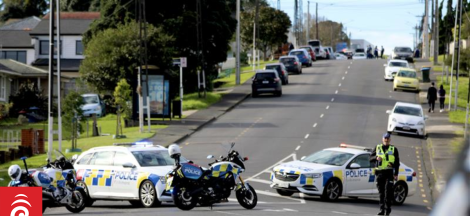- Tariff volatility continues to dominate markets and
the outlook. We’re far from any resolution. And the
fragility of the global economy poses significant risk to
our recovery here at home. - Aware of all the risks,
the RBNZ cut the cash rate to 3.25% last week. And despite
the uncertain path ahead, there’s more cuts coming.
That’s the key takeaway from the May MPS. - Our COTW
takes a look at the curious sell off in Kiwi rates following
the RBNZ policy decision.
Here’s our take on
current events
After a hectic month marked by a
whirlwind of trade escalations and de-escalations, the
Government’s budget release, and last week’s RBNZ
Monetary Policy Statement, May has officially come to a
close. The mayhem, however, is far from over. Tariff
volatility continues to dominate financial markets. Whether
it’s the ongoing legal battle between the Trump
administration and the courts over the legality of the
“Liberation Day” tariffs, or the renewed tensions between
the US and China – with each side accusing the other of
violating their trade truce – or the proverbial (not
literal!) shots aimed at the European Union, the economic
landscape remains incredibly fragile.
There’s a lot
of noise right now. And it’s hard for everyone, including
policymakers, to make sense of it all. The RBNZ’s latest
statement alone mentioned the word uncertain, or some or a
form of it, 164 times across their 60 or so page statement.
That’s about 3 mentions a page…
Advertisement – scroll to continue reading
Nevertheless, the
RBNZ delivered on expectations and delivered another 25bps
cut. The cash rate sits at 3.25%. And there’s more cuts
coming. That’s the key takeaway from the May MPS. Although
the path from here is highly uncertain.
The OCR track
was lowered from a flat lined bottom of 3.10% to a 2.85%
trough in March 2026. So now another 25bps cut to 3% is
fully baked into the cake. And from there, there’s a 60%
chance of another 25bps cut to 2.75%. Once again, we would
love to have seen a bit more. We’re still of the view that
a 2.5% cash rate is what the Kiwi economy needs. And an OCR
track bottoming anywhere below 2.75% would have signalled
what we had hoped to see.
But with each MPS, the
terminal OCR has moved closer to our 2.5% view. Give them
time, and they just might get there. But for now, such
heightened uncertainty is making it harder for all
policymakers to navigate. So, it’s not surprising to see
the committee err on the side of caution. The fact the RBNZ
“voted” 5-1, with one member opting for a pause to
assess, throws some doubt on the timing of the next move,
but not the direction. They are not on a “pre-set
course”, and always data dependent. We think there’s
enough for them to cut again in July, but they may wait
until August to cut again. It depends… on what?
Everything.
All in all, we think there was a bit in
the May MPS for everyone, dove or hawk. The RBNZ’s
forecasts were markedly revised lower. The expected Kiwi
economic recovery is forecast to be slower than projected in
the February MPS with the RBNZ now forecasting 0.7% growth
this year, down from 1%. And greater spare capacity than
previously modelled also sees unemployment stay higher for
longer. You can’t ignore that. And that’s the dovish
part.
The hawkish part lies in the dissenting 5-1 vote
and the accompanying hawkish tone in post MPS media
conferences. Comments from Hawkesby including the statement
that the Committee will have “no clear bias” heading
into the July meeting, injected a dose of uncertainty. And
together, these seeds of doubt gave markets something to run
with. Rates, particularly in the short end saw a sizeable
jolt higher (see our COTW for move on the move in markets).
But we think markets, as they so often do, have gotten a bit
carried away. Time will tell.
Charts of the
Week: A less dovish, highly uncertain, RBNZ bias generated a
mixed reaction in markets.
If you just read
the statement, the RBNZ’s easing bias was strengthened.
The economic forecasts were cut, and another 25bp rate cut
was inserted into the OCR track (from a low of 3.1% to
2.85%). The track shows a clear bias to cut to at least 3%
and there’s a 60% chance of a cut to 2.75%. That’s
dovish. Because they’re still cutting. Our first chart
shows with each MPS over the last year, the terminal OCR has
moved closer to our 2.5% view. Give them time, and they just
might get there.
The FX market read the statement. The
Kiwi currency barely moved. The Kiwi currency reacted
exactly as you’d expect. It fell. It rose. And then it
fell again. It looked like a heart rate monitor around
.5950. There wasn’t much change at all. There are bigger
issues offshore for currency traders to grapple
with.
If you listened to the press conference, the
RBNZ’s top brass were crystal clear in their clouded
uncertainty. Heightened uncertainty is making it harder for
all policymakers to navigate. So, it’s not surprising to
see the committee err on the side of caution. The fact the
RBNZ “voted” 5-1, with one member voting for a pause to
assess, throws some doubt on the timing of the next move,
but not the direction. They are not on a “pre-set
course”, and always data dependent. We think there’s
enough for them to cut again in July, but they may wait
until August to cut again. It depends… on what?
Everything.
It was the “vote”, the first time in
two years, that got interest rate traders (re)thinking. That
seed of doubt caused a bit of a jolt, especially short end
interest rates. The pivotal 2-year swap rate rose 10bps,
from 3.16% to 3.26% (now 3.32%), as the implied terminal
cash rate lifted from 2.85% to 2.95% (now 3%). See the
second chart. It’s not a big move… but it was one
Governor Christian Hawkesby pushed back on. The telling
comment from Hawkesby, when asked about the market reaction,
was his reference to the new OCR track matching market
pricing prior to the announcement. The RBNZ’s OCR track
matched market pricing of 2.85%. So they would not have
expected much reaction at all.
We believe we are
seeing some profit taking in wholesale rates markets. Hedge
funds would have placed some bets that the RBNZ may have
come out a lot more dovish.
We think the market will
settle down, and end up moving back down to 2.85%, in time
(and depending on what happens in offshore markets). And
then, we expect another move by markets and the RBNZ down to
2.5%.




